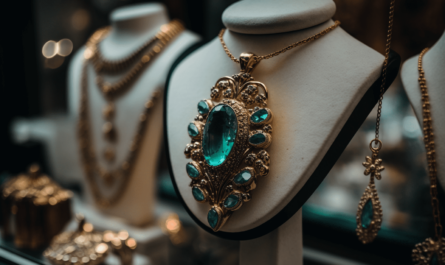The glint behind a jewelry store’s glass windows often tells stories of artistry, craftsmanship, and commerce. A necklace isn’t just a series of interlocked metals or a ring merely a band with a stone. Within these pieces lie tales of tradition, innovation, and strategic business acumen. Dive with us into this luminous world as we unveil the duality of the jewelry retail landscape: its art and its business.
The Jewelry Retail Landscape
The world of jewelry retail is as diverse and multifaceted as the gemstones it showcases. At one end of this expansive universe, we find luxury boutiques—refined spaces that echo exclusivity and opulence, housing collections from renowned designers that captivate with their elegance. These boutiques become destinations in themselves, offering not just jewelry but a slice of a lavish lifestyle.
Conversely, the charm of mom-and-pop stores lies in their intimacy and warmth. Here, relationships are forged over generations, and the joy of purchase often intertwines with familiar faces and stories of yore. It’s not just about buying a piece of jewelry; it’s about reliving memories and creating new ones.
But the modern jewelry landscape isn’t confined to brick-and-mortar alone. Online retailers have carved a significant niche, erasing geographical boundaries and introducing consumers to a world of designs with just a click. The convenience they offer, combined with the vastness of choice, makes them a force to reckon with.
Adding another layer of depth are the artisanal pop-ups, where creativity knows no bounds. These platforms champion the cause of individual artists and their unique narratives, presenting handcrafted pieces that resonate with authenticity and passion.
Crafting and Curating: The Artistry of Jewelry Retail
Jewelry, in essence, is a tangible reflection of intangible emotions, stories, and dreams. At the helm of this transformation from the ethereal to the real are jewelry designers. Their canvas, gleaming metals and radiant gemstones, is but a medium to give wings to their imagination.
Drawing from the vast reservoir of nature’s wonders, the richness of diverse cultures, deeply personal experiences, or even the boundless realms of imagination, they craft not just jewelry but a piece of art. But this journey from conception to creation is steeped in challenges. Designers need to have more than just a keen aesthetic sense. They must possess a profound understanding of the materials they work with, their properties, how they interact, and how they would feel against the skin. It’s where the intricacies of ergonomics come into play, ensuring that a piece, no matter how extravagant, sits comfortably when worn.
Furthermore, designers also need to be astute market readers, understanding and sometimes even anticipating market desires. It’s a delicate balance—staying true to one’s artistic vision while ensuring the piece finds its admirers. When this intricate dance of art and science is choreographed flawlessly, the result is nothing short of a timeless masterpiece. For insights into the world of jewelry design and the creative process, you can explore resources provided by industry associations and educational institutions such as the Gemological Institute of America.
The Business Side of Sparkle
- Inventory Management
- Procurement: The foundational step, involving sourcing the finest materials, whether it’s gemstones, metals, or finished pieces from esteemed designers.
- Cataloging: Each item must be accurately logged, detailing specifics such as type, size, source, and price.
- Storage: This involves ensuring that items are securely stored, often requiring specialized storage solutions for delicate or high-value pieces.
- Stock Rotation: With changing seasons and trends, stock must be routinely assessed, and rotations must be made to keep displays fresh and relevant.
- Staff Training
- Product Knowledge: Equip staff with comprehensive knowledge about the various jewelry pieces, their origin, care methods, and significance.
- Customer Service Excellence: Training sessions to ensure staff interact gracefully, understand customer needs, and offer solutions that resonate with individual preferences.
- Handling and Presentation: Instructing staff on the correct methods to handle jewelry items, especially delicate or antique pieces, and how best to present them to customers.
- Sales Techniques: Techniques not just to sell but to create lasting relationships, ensuring customers return for future purchases.
- Point of Sale Procedures
- Transaction Management: Efficient systems to handle transactions, be it cash, card, or digital payments.
- Customer Data Handling: Safeguarding personal customer information, understanding preferences for future reference, and ensuring privacy policies are adhered to.
- Packaging and Delivery: Ensuring that purchased items are beautifully packaged, enhancing the unboxing experience. Plus, offering delivery services, especially for high-value items, ensuring they reach customers safely.
- After-Sale Services
- Warranty and Repairs: Offering services to repair or service jewelry items, ensuring they retain their luster and value.
- Returns and Exchanges: Having clear policies in place that protect both the business and the customer’s interests.
Customer Experience and Service
In the world of jewelry, each piece isn’t just an ornament but often a symbol of sentiment, making the shopping experience intensely personal. Customer service goes beyond mere transactions; it delves into understanding emotions, aspirations, and sometimes, even the unspoken. As customers step into stores, they’re met with meticulously crafted interiors, soothing music, and inviting displays. But it’s the staff, their empathetic approach, and their genuine desire to assist that makes all the difference. They’re trained to gauge the needs of each visitor, offer advice when sought, and allow space when needed. It’s not just about the present moment but about forging relationships that span anniversaries, birthdays, and generations.
The Future of Jewelry Retail
With each passing day, the jewelry industry witnesses subtle shifts. Driven by technological advancements, there’s an increasing pivot towards digital platforms, augmented reality-based trials, and AI-driven personalization. However, parallel to this tech-driven transformation is a rising consciousness about the planet and its people. Consumers today are more informed and concerned about where their jewelry comes from, prompting a move towards sustainability and ethically sourced materials. As challenges like these arise, they’re met with innovation, resilience, and a deep-rooted commitment to keeping the industry’s sparkle alive. The future, while uncertain in specifics, promises a landscape where tradition and innovation coexist harmoniously.
Conclusion
The journey from a jewelry sketch to its place in a display case, and finally, to a cherished spot in someone’s collection, is paved with dreams, determination, and dexterity. Jewelry retail embodies a marriage of artistic flair with astute business acumen. And as we stand, often mesmerized, in front of glinting displays, it’s essential to remember and respect the myriad stories, efforts, and innovations that converge to make that moment possible. The world of jewelry retail, shimmering in its external beauty, holds within its heart tales of passion, perseverance, and promise. In conclusion, we would like to recommend you to read the article in which we told you about real estate for sale in Greece.
FAQ
The jewelry retail landscape encompasses luxury boutiques, intimate mom-and-pop stores, online retailers, and artisanal pop-ups. Luxury boutiques emphasize exclusivity, mom-and-pop stores focus on relationships and warmth, online retailers offer convenience and variety, and artisanal pop-ups champion individual artists and authenticity.
Jewelry designers must understand materials, ergonomics, and market desires to create successful pieces. Balancing artistic vision with market demand ensures that their creations resonate with customers while staying true to their art.
The business side of jewelry retail includes inventory management, staff training, point of sale procedures, and after-sale services. These aspects ensure a seamless and memorable customer experience, reflecting the brilliance of the establishment.


